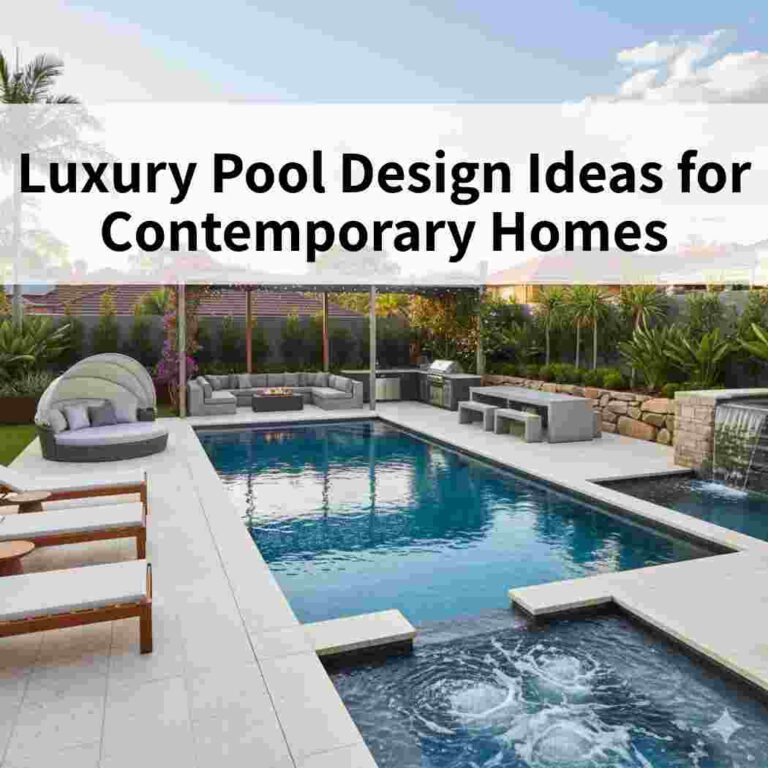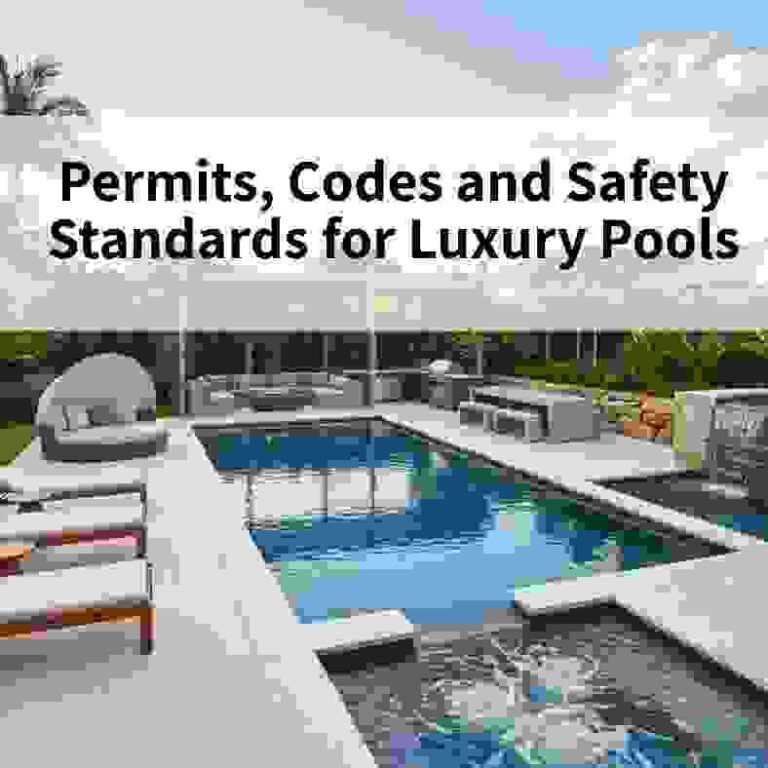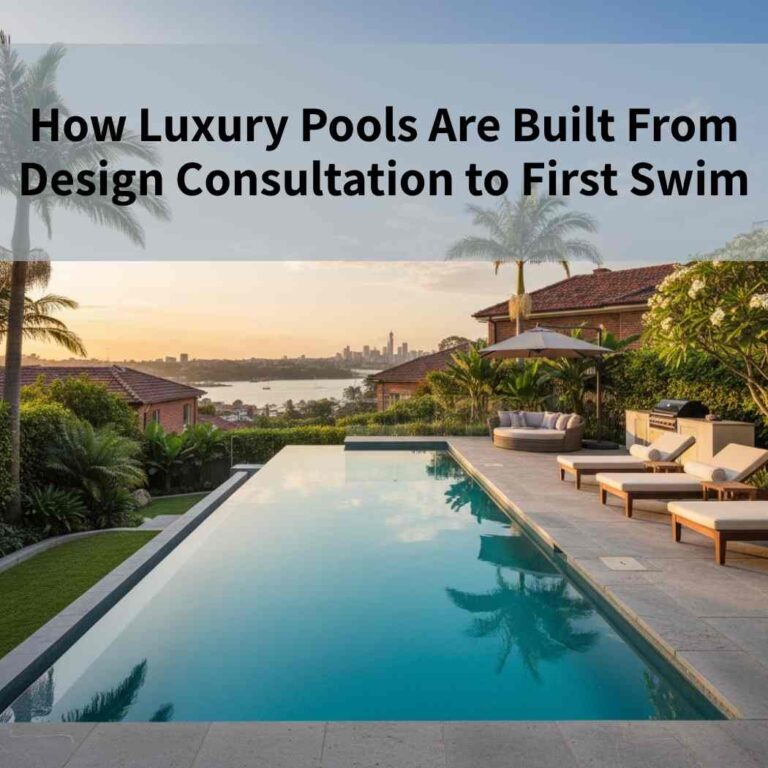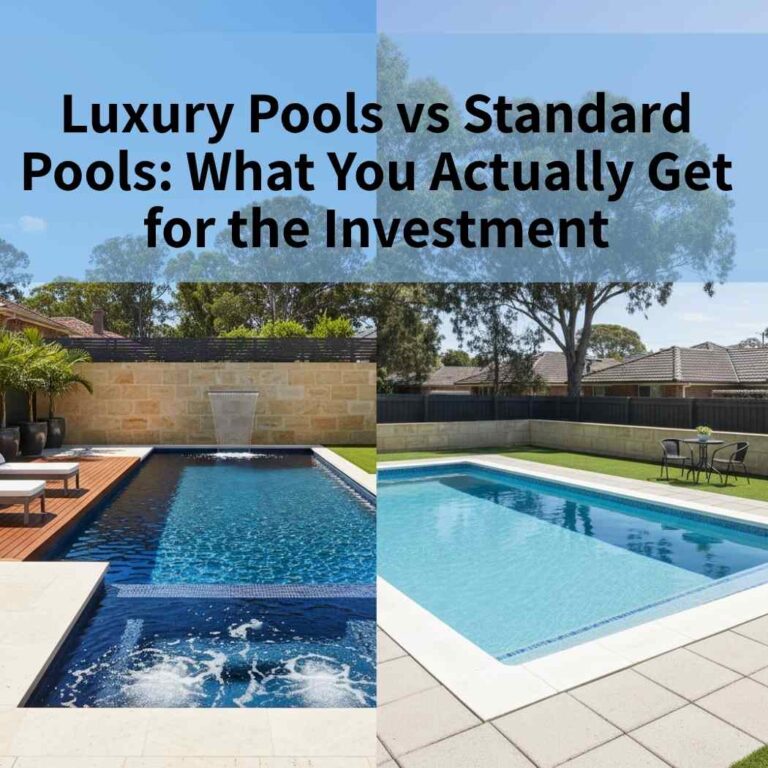At Plunge Pools Sydney, we’ve helped many local families create pools that feel like a holiday at home. Our designs balance style, function, and budget so you can enjoy the look of a resort without overspending.
In this guide, you’ll find practical pool design ideas that match your lifestyle and budget. We’ll cover cost ranges, add-on features, financial risks, and smart ways to plan. By the end, you’ll know how to build a pool that looks amazing, works for every family member, and protects your finances long-term.
Table of Contents
ToggleCore Considerations for Budgeting a Resort-Style Pool
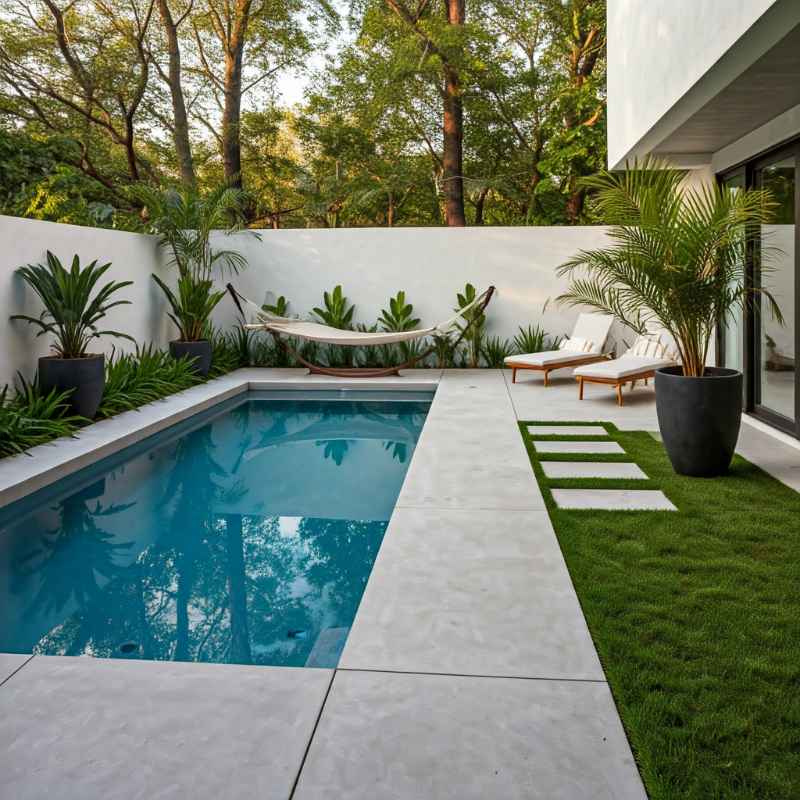
When planning a resort-style pool, start with your budget. The main cost factors are pool size, features, council approval, and backyard conditions.
Key Budget Drivers
- Pool size and depth – Larger, deeper pools cost more to dig and build.
- Luxury features – Waterfalls, slides, and infinity edges add style but raise costs.
- Council approval – Most Sydney pools need a development application (DA) or complying development certificate (CDC). Approval fees and inspections add to the budget.
- Soil type and drainage – Rocky ground, clay, or poor drainage can increase excavation and foundation costs.
- Backyard access – Narrow or sloped blocks may need cranes or special equipment, raising construction costs.
Budgeting for a resort-style pool means more than just choosing a design you love. Start by setting a clear spending limit, then factor in the “hidden” costs that many families miss: permits, soil testing, and access for machinery. A flat block with easy truck access costs far less to work on than a steep, tight city backyard.
Think about the must-haves that matter most to your family. Features like shallow play areas or slip-resistant surfaces may be more important than a rock waterfall or spa. By knowing these considerations upfront, you can design a pool that feels luxurious while keeping spending under control.
Average Cost Ranges
In Sydney, most resort-style family pools cost between $60,000 and $150,000+, depending on size, type, and features.
Typical Sydney Pool Costs
| Pool Type | Average Cost | Notes |
|---|---|---|
| Concrete | $80,000–$150,000+ | Fully custom, suits large or complex builds, higher upkeep |
| Fibreglass | $60,000–$120,000+ | Faster install, limited by mould size, easier maintenance |
| Add-ons | +$5,000–$20,000 | Includes spas, slides, waterfalls, tanning ledges |
Concrete pools sit at the higher end because they’re built on-site with rebar and sprayed concrete (gunite or shotcrete). They offer complete flexibility in size and shape, but you’ll also face longer build times and resurfacing costs down the track.
Fibreglass pools are more affordable upfront and install in weeks, not months. Their smooth gelcoat surface means lower chemical bills and easier cleaning, but their size is capped by what can be transported by truck and lifted in with a crane.
Add-ons such as spa jets, slides, or water features can quickly add $5,000–$20,000 to your build. That’s why it’s smart to decide which extras bring the most value to your family before signing a contract.
How Add-Ons Affect Cost
Add-ons can increase pool costs by $5,000–$20,000+, depending on the feature.
Common Add-On Costs
- Slides & splash zones – Fun for kids, usually add $10,000–$20,000.
- Shallow lounging areas – Great for parents to relax, smaller add-on cost.
- Spa jets or built-in spa zones – Luxury touch, expect $5,000+.
- Water features (simple waterfalls, LED lighting) – From $2,000–$8,000 depending on design.
- Tanning ledges & seating – Safer play areas for kids, $3,000–$7,000.
Add-ons are what make a family pool feel like a resort escape, but they also push costs higher. Slides and splash areas are exciting for kids, but they require more construction work and plumbing. Spa jets or shallow lounging zones give parents a spot to relax, but each comes with extra installation and maintenance.
Simple features like LED lighting or a small waterfall can transform ambience without blowing the budget, while large rockscapes or elaborate spas can add tens of thousands. By listing your family’s “must-haves” first, you can control costs and avoid surprises during the build.
Balancing Luxury and Necessity
A resort-style pool doesn’t need every feature, focus on must-haves first, then add extras if the budget allows.
Must-Haves (Function + Safety)
- Shallow play zones – Safe for kids and multi-use for families.
- Slip-resistant surfaces – Prevents accidents and lowers liability.
- Strong pool fencing – Required by Sydney council regulations.
- Energy-efficient pump and lighting – Reduces long-term running costs.
Nice-to-Haves (Luxury + Style)
- Rock waterfalls or large slides – Eye-catching, but expensive to install.
- Built-in spa jets – Relaxing, but add $5k+ to the build.
- Custom shapes and curves – Stylish, but straight-edge pools are cheaper.
- Elaborate landscaping – Tropical planting or stonework increases costs.
Families often picture a pool filled with luxury touches, but the smartest approach is to separate essentials from luxuries. Safety and function should always come first — shallow areas for kids, slip-resistant finishes, and fencing to meet NSW rules. These features protect your family and save money long-term.
Luxury add-ons like rockscapes, spa zones, or custom shapes create the “wow factor,” but they’re optional. If the budget is tight, start with a well-designed, safe pool. You can always add features or upgrade landscaping later in stages.
Major Financial Risks to Anticipate
The biggest risks are overspending on extras, underestimating maintenance, contractor overruns, and higher heating bills.
Key Financial Risks
- Overspending on extras – Luxury add-ons like rockscapes, spas, or slides can push costs far beyond the budget.
- Underestimating maintenance – Pools need ongoing chemicals, cleaning, and sometimes specialised gear for eco-friendly pool systems.
- Contractor overruns – Poor quotes or vague contracts can lead to scope creep and surprise costs.
- Seasonal usage & heating bills – Gas or electric heating extends swim time, but adds hundreds to thousands each year.
- Site surprises – Rocky soil, drainage issues, or tight access may require extra excavation and equipment.
Building a resort-style pool is exciting, but poor planning can lead to budget stress. Families often get caught by overspending on non-essential features, things that look nice but don’t add much daily value. Another common trap is underestimating maintenance costs: even “eco-friendly” pools need specific pumps, filters, or covers, which can be costly to replace.
Contractor overruns are another big risk. If bids don’t clearly spell out what’s included, you may face unexpected charges for excavation, plumbing, or landscaping. Always compare at least three detailed quotes.
Finally, think about seasonal costs. Heating can extend the season, but running a gas or electric system in Sydney can add thousands each year. Solar or heat pumps are cheaper over time, but still need upfront investment. By spotting these risks early, families can plan smarter and avoid financial strain.
Financing & Payment Options for Families
Sydney families usually finance pools through personal loans, mortgage redraws, or staged payments with builders.
Common Financing Options
- Personal loan – Fast access to funds, but usually higher interest rates.
- Mortgage redraw or top-up – Lower rates than personal loans, but spreads repayments over 10–15+ years.
- Staged payments with builder – Payments tied to milestones (excavation, shell, finishes), easier on cash flow but needs careful planning.
- Pool-specific financing plans – Some builders partner with lenders to offer structured repayment packages.
The way you finance your pool affects its long-term affordability. A personal loan gives quick approval and flexibility, but often comes with higher interest rates. A mortgage redraw or top-up usually offers a better rate, but extends your home loan, meaning you’ll pay more interest across the full term.
Many Sydney pool builders also allow staged payments, splitting costs across project milestones like excavation, shell delivery, and final finishes. This helps manage cash flow but requires disciplined budgeting. Some even offer pool financing plans in partnership with banks or brokers.
Tip: Always calculate the total cost of interest. A $70,000 pool financed at 6–7% over 15 years could add tens of thousands in repayments, so it pays to compare your options carefully.
Budget-Smart Family-Friendly Features
Here’s the good news: a pool can still look and feel like a resort without huge costs.
- Shallow play areas vs splash parks: Safer for kids, cheaper for parents.
- Simple waterfalls vs rockscapes: A decorative feature adds ambience without blowing the budget.
- Multi-use pools: A lap pool that doubles as leisure space reduces redundancy.
- Safety and value: A strong pool fence, slip-resistant surfaces, and shallow zones keep costs down long-term.
Cost Management Mechanisms
Phased Build Approaches
Can’t afford everything upfront? Build the outdoor space in stages. Start with the core pool, then add pool landscaping ideas later.
Contingency Reserves
Always set aside 10–15% extra. Unexpected issues around the pool like soil movement or drainage can cause costs to rise.
Comparing Contractor Bids
Cheapest isn’t always the best pool option. Look for builders who include warranties and after-care.
Choosing Materials With Better ROI
Energy-efficient pumps, LED lighting, and durable finishes are ideas that work for long-term savings. A modern pool finish may cost more upfront, but reduce lifetime expenses.
Lifecycle Ownership Costs to Plan For
Many families plan for the upfront build but overlook long-term ownership expenses:
- Heating: Gas, solar, or heat pumps can add $500–$2,000+ a year.
- Cleaning & chemicals: Automated cleaners and regular treatments average $800–$1,200 annually.
- Insurance: Pools increase home insurance premiums.
- General upkeep: Resurfacing, replacing equipment, or fence maintenance all add to lifetime costs.
Tip: Energy-efficient pumps, LED lighting, and modern finishes cost more upfront but reduce yearly expenses and extend durability.
Cost Trade-Off Scenarios for Different Budgets
Even with limited funds, you can still capture a resort feel by making practical swaps:
- Timber-look composite decking instead of natural hardwood – keeps costs down while still looking high-end.
- Solar heating instead of gas heating – slower to warm, but saves hundreds each year.
- Simple straight-edge pool shapes instead of custom curves – easier and cheaper to construct.
- LED feature lighting instead of a full water feature – adds ambience without the $10k+ price tag.
Decision-Making Guide for Families
Smart choices help keep your pool fun, safe, and sustainable for years to come.
Must-have vs nice-to-have: Write a checklist and prioritise.
Lifetime cost thinking: Consider not just the upfront cost but also how features impact the next 10 years.
Trade-offs: Sometimes a smaller pool with quality materials delivers better value than a larger one that’s costly to run.
These choices ensure you make your pool fun, safe, and sustainable.
Talk to a project specialist →Financial Risk Checklist for Sydney Families
Before signing any contracts, use this clear checklist:
- Confirm warranty inclusions and after-care support with your builder.
- Set aside a 15% contingency fund for surprises.
- Always compare at least 3 bids — focus on inclusions, not just price.
- Review ongoing service costs (chemicals, heating, cleaning) before committing.
Real-World Tips From Local Families
Sydney homeowners often find success with these pool ideas:
- Mix play and relaxation: shallow ledges for kids, deeper sections for adults.
- Stay simple: clean shapes, easy finishes, low-cost landscaping.
- Use smart design: well-placed seating, storage for toys, and safe access.
Great pool landscaping ideas create harmony between your backyard and pool, making it feel like a holiday escape. Even in a small backyard, clever pool and garden design can completely transform your backyard into something luxurious.
Conclusion
Building a resort-style pool for your family doesn’t mean emptying your savings. With the right planning, cost checks, and smart pool landscaping ideas, you can enjoy luxury and fun while protecting your finances.
At Plunge Pools Sydney, we specialise in resort-style pool designs that suit Sydney homes. From pool and garden integration to best pool landscaping ideas, we guide you through every stage. Whether you’re designing an indoor pool or an outdoor retreat, we’ll help you choose pool features that balance style and budget.
Ready to plan your dream pool? Contact us today, and let’s design a pool that looks amazing, works for your family, and blends beautifully with the area around your pool.
FAQs
Do resort-style pools need council approval in Sydney, and what permits are required?
Yes, most resort-style pools in Sydney require council approval and compliance with NSW swimming pool regulations. You’ll usually need a development application (DA) or a complying development certificate (CDC), along with inspections for fencing and safety. Checking requirements with your local council early prevents costly delays and ensures your pool meets Australian Standards.
How can landscaping choices affect the overall cost and design of a resort-style pool?
Landscaping can greatly increase or reduce the cost of a resort-style pool. Simple decking, turf, or pavers are budget-friendly, while stonework, retaining walls, and tropical planting can push prices higher. Smart landscaping not only controls costs but also creates the “resort feel” that transforms a family pool into a luxury space.
What financing options are available for families building a pool in Sydney?
Families in Sydney can finance a pool through personal loans, home equity loans, or by adding it to their mortgage. Each option has different interest rates and repayment terms, so it’s best to compare before committing. Setting a clear budget and talking to your bank or broker helps you choose the most affordable path.
How do pool heating systems impact running costs for a resort-style pool?
Pool heating can significantly increase ongoing costs, especially with gas or electric systems. Solar heating is cheaper to run but depends on the weather, while heat pumps balance efficiency with year-round comfort. Choosing the right system helps families enjoy longer swim seasons without a big jump in electricity bills.
Can a plunge pool be designed to look and feel like a resort-style pool?
Yes, a plunge pool can be styled to mimic a resort look with the right finishes and features. Adding timber decking, water features, LED lighting, or surrounding greenery can create a luxury feel even in a small space. This makes plunge pools a cost-effective option for families wanting style on a budget.
What are the most common mistakes Sydney homeowners make when budgeting for a resort-style pool?
The biggest mistakes are underestimating long-term maintenance, overspending on extras, and not leaving a buffer for unexpected site costs. Many homeowners also overlook ongoing expenses like cleaning, heating, and insurance. Planning carefully and comparing builder quotes early helps avoid these financial traps.

